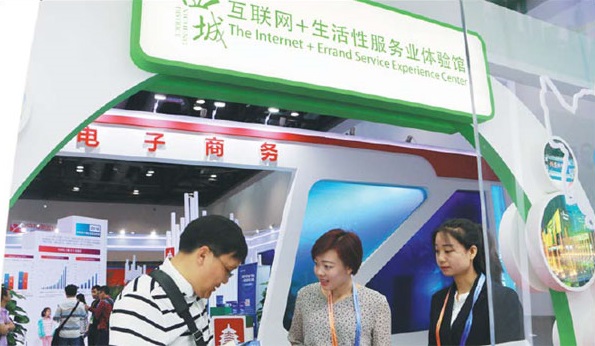
Visitors learn about e-commerce services at an internet-based experience center at the 2017 China Beijing International Fair for Trade in Services.Photos By Li You / China Daily
New report reveals online shopping reached $3.81 trillion in 2016, with numbers expected to rise
The total trade turnover of China's e-commerce market in 2016 amounted to 26.1 trillion yuan ($3.81 trillion), an increase of 19.8 percent year-on-year, according to the 2016 China E-commerce Report released on Monday at the 2017 China Beijing International Fair for Trade in Services.
Compared with the surge in e-commerce over the past five years that has averaged 34 percent annually, 2016 showed an obvious fall, indicating China's e-commerce entering a period of steady development, said Nie Linhai, inspector at the Department of Electronic Commerce and Information of the Ministry of Commerce.
According to the report, the users of online shopping applications and platforms reached 467 million, accounting for 63.8 percent of all Chinese netizens.
"But the growth rate of Chinese netizens is slowing down. New impetus in e-commerce consumption won't emerge unless the participants in e-commerce can break the bottleneck of the sluggish browsing volume," Nie said.
E-commerce in 2016 indeed indicated some new phenomena, however, according to Nie.
First, it facilitates supply-side structural reform. By precise calculation through real-time monitoring and big data analysis, information about demand can guide the volume of supply, for more efficient, personalized service.
As the digital economy shows rapid growth amid implementation of the Internet Plus strategy all over the country, e-commerce has become a significant part of it.
Second, the traditional retail industry is transforming. From the circulation channels and supply chains, to data collection and trading, the online and offline aspects are gradually opening up for each other, pointing to a convergence of their further development. In 2016, with social network e-commerce featuring web celebrities, WeChat business reached a new level.
Online retailers and social networking platforms have been integrated with pictures, video and live broadcasting.
In recent years, new formats and patterns of online retail are emerging. B2B experienced strong development. Increasingly efficient information exchanges between the demand and supply sides conducted through e-commerce platforms solved the issues of excess capacity, high circulation cost and invalid supply.
Finally, cross-border e-commerce has continued to thrive under new governmental regulations.
It plays a positive role in stabilizing foreign trade and promoting innovation.
"Online shopping's quality and customer experience should be improved by removal of technical limitations. Through technological innovation, e-commence can embrace new opportunities brought about by the upgrading of consumption," Nie said.
At present, the development of e-commerce has entered a new phase. The advantage of e-commerce, compared with traditional retail, is its digitized operation, as it can better process and analyze customers' appetites, said Xu Danxia, head of XBN, a crossborder e-commerce platform.
Pactera Technology International, a leading software service provider in China, has upgraded its technology to ensure greater convenience for its e-commence clients.
It provides solutions for e-commerce platforms in the fields of product display, search, order processing, logistics and payment methods through new online applications.
It helps to realize value-added services of online shopping platforms based on digital calculations.
"In the past six years, China's e-commerce has undergone extraordinary development. We have together witnessed China becoming the largest and fastest-growing e-commerce market in the world," said Wang Bingnan, assistant minister of the Ministry of Commerce.
At present, e-commerce is one of the most vigorous fields of China's economy, and the rapid development of various new formats and modes is an important highlight in China's economic development, said Wang.
The 2016 China E-commerce Report was compiled by the Ministry of Commerce who organized experts and industrial insiders to perform deep research on the industry.
The report was released at the 2017 China E-commerce Conference during the 2017 CIFTIS.


















































